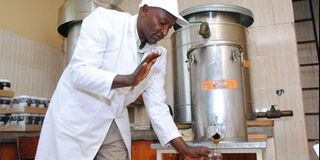For sweet honey, give your bees tasty food

Joseph Kamiri the person in charge of Bee Keeping at Baraka Agricultural College packing honey ready for sale.The package goes up to 7kg and 40gms as the lowest. PHOTO |JOHN NJOROGE| NATION MEDIA GROUP.
What you need to know:
- The quality of honey is determined at the production level
- An apiary should be placed under a shade so that the beehives are shielded from direct sunlight and wind.
- It should not be more than 300 metres from a water source since bees need water to dilute the honey and cool the hive during a hot weather.
- It should also be placed away from pollutants like factories to ensure the honey remains natural and the farmer should consider the safety of the people around in case the bees leave the hives.
You must be knowing one of the ways to detect the quality of honey.
Some people turn the container upside down to check the colour while others believe the lighter the honey, the top the quality.
Still, others check if the viscosity is smoother to know if it is better.
While these checks help, they may be misleading, according to Joseph Kamiri, the officer in-charge of beekeeping at Baraka Agricultural College in Molo town, where a majority of farmers go for lessons.
Kamiri notes that the quality of honey is determined at the production level.
“The making of good honey begins at the moment a farmer decides to be a bee keeper,” he says, adding that establishment of an apiary determines how the bees will feed to produce honey.
An apiary should be placed under a shade so that the beehives are shielded from direct sunlight and wind.
It should not be more than 300 metres from a water source since bees need water to dilute the honey and cool the hive during a hot weather.
It should also be placed away from pollutants like factories to ensure the honey remains natural and the farmer should consider the safety of the people around in case the bees leave the hives.
“Farmers should also ensure the apiary is free of rodents, snakes and lizards by acquiring standard hives that have a small entrance where the predators cannot access,” Kamiri notes.
Once the hive is placed at the desired location, a farmer is advised to apply grease on the hanging wires to make it hard for crawling insects to access the beehive.
The bees are lured into the hives by applying wax inside, which attracts a colony. He warns against giving bees artificial feeds like molasses and by products from soft drinks, noting this inhibits them from producing natural honey. The bees, he says, should feed on organic nectar from trees and flowers. In the highlands, avocado, pawpaw and eucalyptus trees and Dombeya and Lady’s ear drop plants offer the best foliage for good nectar. In the lowlands, acacia tree is the best since it has medicinal value that is incorporated in the honey.
For a new hive, it takes an average of six months before the honey is ripe for collection.
“This is because the bees will first build up their colony before they start producing honey. For the subsequent times, it will take two to three months, depending on the size of the colony,” says Kamiri.
One can use the Langstroth or Kenya Top Bar hives to keep bees as they are most preferred because they are easy to manage.
When it comes to the collection and processing of honey from the hives, Kamiri says the containers used should be made from non-corrosive material like stainless steel, brass, aluminium or plastic as honey is acidic in nature.
Three types of honey, in terms of quality, exist. These are crude, which is direct from the hive and has the honey combs, semi-refined from which the combs have been removed and pure or refined which has been warmed and has passed through sieves to extract any particles of dirt or honey combs.
“In terms of colour, honey ranges from amber to brown. Good honey is in this range and does not have particles in it. It also has a sweet taste that does not irritate the tongue,” says Kamiri.
The colour of the honey is determined by the nectar and foliage that the bees feed on during the honey making process.
On the other hand, moisture content, measured by a refractometer, determines the honey flow (viscosity). The lower the moisture content, the higher the viscosity.
One of the most popular and reliable quality checks, according to Kamiri, involves dipping a matchstick in the honey and striking it on a match box. Good honey will light.
while one that is adulterated will produce smoke and go off.”




